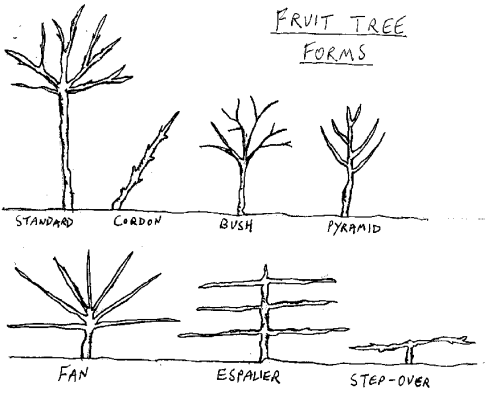(ported main text from PermaWiki. ported table from Wikipedia due to formatting errors on PW. both versions should eventually be reconciled (eg: SI vs. Imperial units, potentially missing info)) |
mNo edit summary |
||
| Line 22: | Line 22: | ||
crown. | crown. | ||
'''Step-over espaliers''' have single horizontal branches | '''Step-over espaliers''' have single horizontal branches at 1’ from the ground and make a | ||
novel and productive border to the vegetable plot. | novel and productive border to the vegetable plot. | ||
Revision as of 20:21, 20 March 2019

The shapes of most fruit trees can be manipulated by pruning and training in order to increase yield, or to improve their suitability for different situations and conditions. Pruning a tree to a pyramid shape means that trees can be planted closer together. An open bowl or cup form increases the penetration of sunlight, thus encouraging a high fruit yield whilst keeping the tree short and easy to pick from. Other shapes such as cordons, espaliers and fans offer opportunities for growing trees two dimensionally against walls or fences, or can themselves be trained as barriers.
Bush trees are the traditional open goblet shaped form, with a clear lower stem.
Cordons are single stemmed trees with fruiting spurs planted at an angle. Any side branches are removed by pruning. cordons take less space and crop earlier than most other forms which means that more varieties can be got into a small space, but yields are smaller per tree.
Espaliers have a central vertical trunk with three or four horizontal branches each side.
Fans have a short central trunk with several radiating branches growing from the crown.
Step-over espaliers have single horizontal branches at 1’ from the ground and make a novel and productive border to the vegetable plot.
All of these shapes require training by tying the branches to the required form, and pruning to retain the desired structure. This is usually carried out in autumn for major cutting back and late summer for light trimming. Autumn pruning encourages woody growth whilst late summer pruning encourages fruiting. Not all trees will accept all of the shapes above- apples and pears do well as cordons and espaliers for example, whereas cherries prefer to be fanned.
Yield and spacing
| Apples and pears | Yield | Spacing | ||
|---|---|---|---|---|
| Apples | Pears | In rows | Rows apart | |
| Bush | 25–50 kg | 20–45 kg | 4–5 m | 4–5 m |
| Dwarf bush | 15–25 kg | 10–20 kg | 2.5–5 m | 2.5–5 m |
| Dwarf pyramid | 5–7 kg | 3–5 kg | 1.5–2 m | 2 m |
| Espalier (two tier) | 10–12 kg | 7–10 kg | 3–6 m | 2 m |
| Fan | 5–15 kg | 5–15 kg | 4–5 m | - |
| Single cordon | 2–4 kg | 2–3 kg | 0.5–1 m | 2 m |
| Standard | 50–200 kg | 40–100 kg | 6–10 m | 6–10 m |
| Other tree fruits | Yield | Spacing | |
|---|---|---|---|
| In rows | Rows apart | ||
| Bush (sour cherry) | 15–20 kg | 4–5 m | 4–5 m |
| Bush (plum and peach) | 15–30 kg | 4–5 m | 4–5 m |
| Bush, standard (sweet cherry) | 15–50 kg | 5–12 m | 5–12 m |
| Fan (all stone fruits) | 7–15 kg | 4–5 m | - |
| Fan (sweet cherry) | 6–15 kg | 5-7.5 m | - |
| Pyramid (plum) | 15–25 kg | 3–4 m | 3–4 m |
| Standard (plum, peach and apricot) | 15–50 kg | 5-7.5 m | 5-7.5 m |